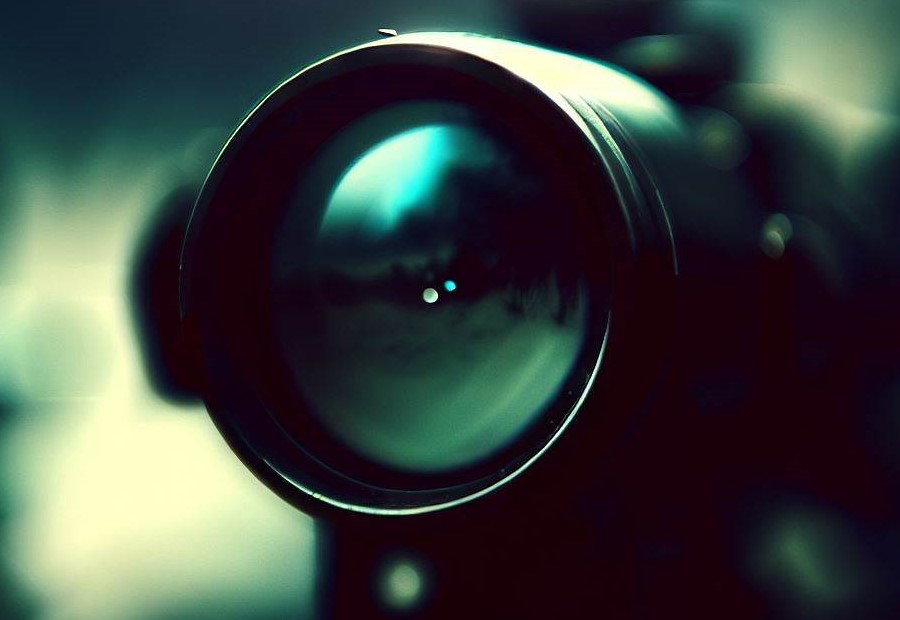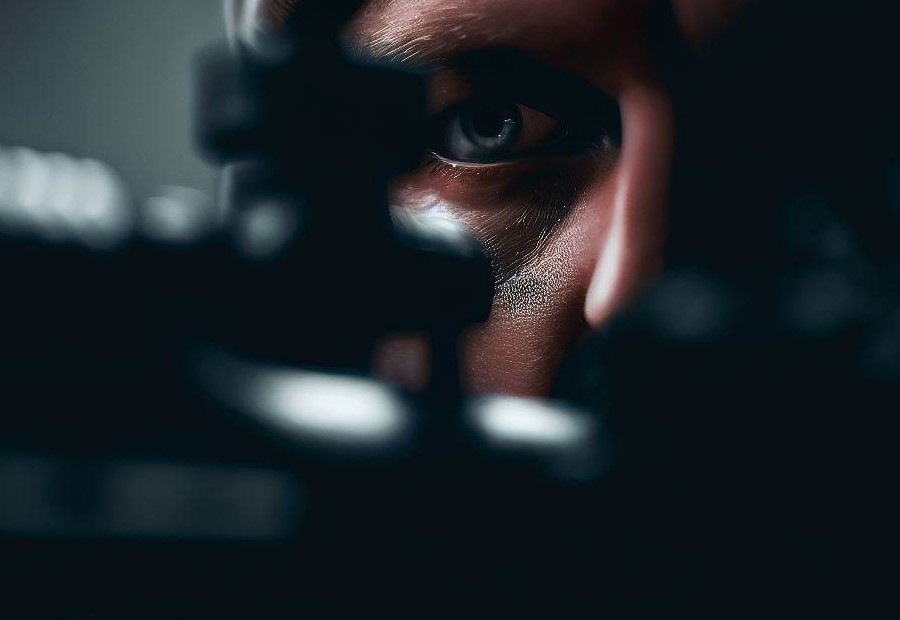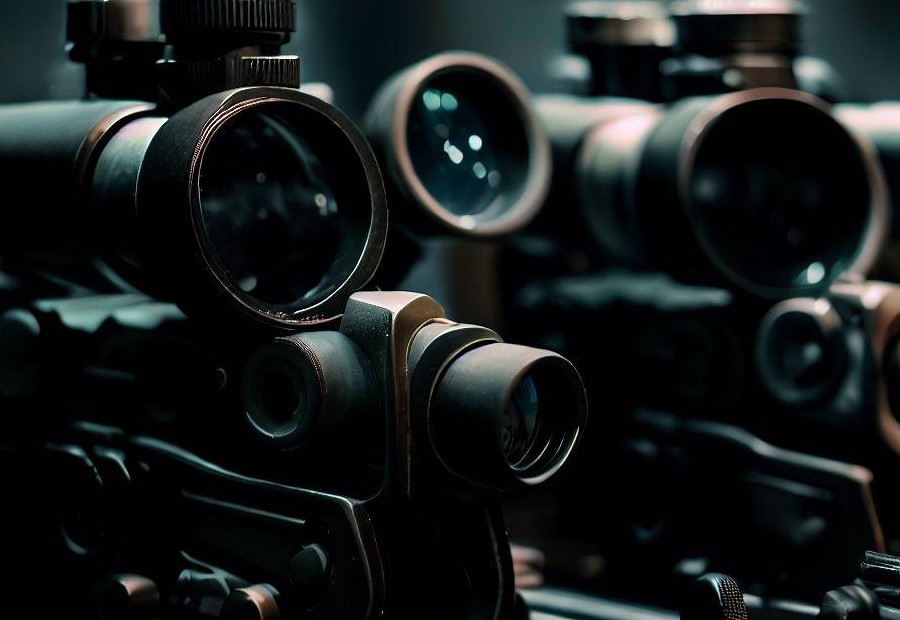The use of scopes and sights is common in various fields such as shooting sports, hunting, and military applications. However, many people often confuse the two or use the terms interchangeably. It is important to understand the difference between a scope and a sight to make an informed decision when choosing the right equipment for your needs.
A scope is an optical device that provides magnification and targeting capabilities. It is typically used in firearms and consists of lenses, an eyepiece, and sometimes an illuminated reticle. Scopes come in different types, such as fixed power scopes, variable power scopes, and red dot scopes, each offering specific advantages depending on the intended use. The primary function of a scope is to magnify the target, making it appear closer and enabling more precise aiming.
On the other hand, a sight is a non-magnifying aiming device that provides a simple reticle or reference point for target acquisition. Sights are commonly used in close quarters combat or situations where fast target acquisition is crucial. There are different types of sights, including iron sights, holographic sights, and reflex sights. Unlike scopes, sights do not offer magnification capabilities but provide a clear reference point to align with the target.
The main differences between scopes and sights lie in their magnification capabilities, reticle types, usage, purpose, and the level of accuracy they provide.
Scopes offer variable levels of magnification, allowing for precise target identification and engagement at different distances.
They often feature complex reticles with bullet drop compensation markings to account for bullet trajectory at various ranges. Sights, on the other hand, do not offer magnification and typically have simple reticles for quick target acquisition in close-range scenarios.
When deciding which option to choose, several factors should be considered, such as the intended use, the distance you will be shooting, the level of precision required, and personal preferences. Scopes are ideal for long-range shooting or when higher levels of accuracy are crucial. Sights are suitable for short-range engagements and situations that require rapid target acquisition and maneuverability.
What is a Scope?
A scope is an optical device used to provide magnification and better visibility for a target. It is commonly used in firearms, cameras, and telescopes. A scope allows the user to see farther and with greater clarity. It typically consists of a tube, lenses, and crosshairs for aiming.
So, what is a scope? The magnification power of a scope varies, with common ranges being 3x to 9x or 4x to 12x. The higher the magnification, the more detail can be seen. Some scopes also have adjustable zoom levels for versatility in different situations.
When using a scope, it is important to align the crosshairs with the target to ensure accurate aiming. Scopes are often used by hunters, snipers, and sports shooters to improve their accuracy and precision. They provide a clear and focused view, making it easier to hit targets at various distances.
Types of Scopes
There are various types of scopes, each serving different purposes and offering different features. Below is a table highlighting some common types of scopes:
| Type of Scope | Magnification Range | Reticle Type |
|---|---|---|
| Rifle Scope | 3-9x | Crosshair |
| Spotting Scope | 20-60x | Angled |
| Astronomical Scope | 70-300x | Dobsonian |
| Microscope | 40x-1000x | Compound |
Rifle scopes are commonly used for hunting and shooting sports. They offer adjustable magnification and utilize a crosshair reticle to aid in aiming.
Spotting scopes are designed for observing distant objects, making them popular among bird watchers and nature enthusiasts. They have a high magnification range and are often angled for comfortable use.
Astronomical scopes are used for stargazing and celestial observations. These scopes have a wide magnification range and employ a Dobsonian mount for stability.
Microscopes are used for scientific and medical purposes, allowing for highly detailed examination of small objects. They offer a wide magnification range and typically use a compound reticle.
When choosing a scope, consider the intended use, desired magnification range, and the type of reticle that suits your needs. Each type of scope has its own strengths and weaknesses, so it’s important to choose the one that best fits your specific requirements.
How Does a Scope Work?

A scope functions by utilizing a combination of lenses and reticles to assist shooters in accurately aiming at their target. The lenses within a scope are specially designed to magnify the image, thereby improving visibility and precision. The reticle, also known as the crosshair, aids the shooter in aligning the firearm with the target.
To simplify the mechanics of a scope, light enters through the objective lens, situated at the front of the scope. The light then passes through a series of lenses that work collaboratively to focus the image and provide magnification. Within the scope, the reticle is positioned to help the shooter align their aim by placing the target in relation to the crosshairs.
Here’s a pro-tip: When using a scope, understanding the concept of eye relief is crucial. Eye relief pertains to the distance between your eye and the scope lens. Maintaining the correct eye relief ensures a clear and comfortable view through the scope while also preventing any potential injuries.
Remember, when selecting a scope, it is important to consider factors such as magnification power, reticle type, and durability. This ensures that you have the appropriate scope for your shooting requirements.
What is a Sight?

Photo Credits: Paintballbuzz.Com by Gary King
A sight is a device used to assist in aiming or targeting a firearm or other projectile weapon. It is typically comprised of markers or crosshairs that align with the target, allowing the shooter to aim with precision. The purpose of a sight is to help improve accuracy and ensure that the projectile hits the intended target.
In history, sights have evolved significantly over time. Early sights were simple and basic, consisting of rudimentary markings or notches on the weapon itself. As technology advanced, more sophisticated sights were developed, such as telescopic sights and holographic sights. These modern sights utilize lenses, reticles, or holographic images to provide shooters with improved aiming capabilities.
One notable historical example is the invention of the telescopic sight in the late 19th century. It revolutionized shooting accuracy by allowing shooters to magnify their view of the target, making it easier to aim accurately over long distances. This innovation greatly enhanced marksmanship and had a significant impact on military tactics and sporting competitions.
Types of Sights
| Type | Description |
| Iron Sight | A basic sight that uses a simple metal post at the front and a notch at the rear to align with the target. |
| Red Dot Sight | A non-magnifying sight that uses a small, illuminated dot to aim at the target. It provides quick target acquisition and is popular for close-range shooting. |
| Holographic Sight | A type of sight that uses a holographic reticle projected onto a glass window. It offers a clear and precise aiming point. |
| Reflex Sight | Similar to a red dot sight, it uses a small, illuminated dot or reticle to aim. It allows for both eyes open shooting and provides a wide field of view. |
| Prismatic Sight | A sight that uses a prism to magnify the target image. It offers a compact design and moderate magnification. |
Pro-tip: When choosing a sight, consider your shooting needs and preferences. Iron sights are reliable and don’t require batteries but may not be as precise for long-range shooting. Red dot sights are great for quick target acquisition, while holographic sights offer increased accuracy. Reflex sights provide a wider field of view, and prismatic sights offer magnification without the bulk of a scope. Choose a sight that suits your shooting style and the distance you plan to shoot.
How Does a Sight Work?

A sight is an aiming device that helps align the shooter’s eye with the target. It assists in aiming accurately by providing a reference point to align the firearm or bow. Sights work by offering a visual aid that allows the shooter to align the muzzle or arrow with the target.
There are different types of sights available, including iron sights, red dot sights, holographic sights, and telescopic sights. Iron sights are the most basic type and consist of a front post and a rear notch. Red dot sights use a red dot or reticle projected onto a glass screen to aim at the target. Holographic sights use a holographic image to provide aiming reference. Telescopic sights, also known as scopes, use magnifying lenses to provide a clear view of the target.
To use a sight, the shooter lines up the aiming point or reticle with the target. The shooter then adjusts the sight’s windage and elevation settings, if needed, to ensure accurate alignment. The sight allows for precise aiming, improving accuracy and target acquisition.
It is important to choose the right sight based on your specific needs and shooting preferences. Factors to consider include the type of firearm or bow you are using, the intended use (such as hunting or target shooting), and personal shooting style. Understanding how a sight works and its features will help you make an informed decision when selecting the most suitable sight for your shooting needs.
The Main Differences Between Scopes and Sights
When it comes to scopes and sights, understanding the main differences between them is crucial. In this section, we’ll dive into the key factors that distinguish these two optical tools. From magnification capabilities to reticle types, usage, purpose, and even distance and accuracy considerations, we’ll uncover the unique characteristics that make scopes and sights distinct. So, whether you’re an avid hunter, a sports shooter, or simply curious about optics, get ready to explore the world of scopes and sights like never before.
Magnification
| Aspect | Scope | Sight |
|---|---|---|
| Magnification | Variable magnification options available, ranging from 3x to 25x. | Fixed magnification with no adjustable options. |
In terms of magnification, both scopes and sights offer different advantages. Scopes have the advantage of variable magnification options, allowing the user to adjust the level of magnification.
Typically, scopes offer a range of magnification options from 3x to 25x. This flexibility in magnification is beneficial for targeting objects at various distances, as it enables more precise aiming and improved accuracy.
On the other hand, sights provide a fixed level of magnification that cannot be adjusted. This fixed magnification is suitable for situations where the target distance remains constant or when a predetermined level of magnification is required. Despite lacking adjustable magnification, sights are often preferred for their simplicity and ease of use.
When deciding between a scope and a sight, consider the importance of magnification in your specific use case. If you need the ability to adjust magnification levels for accurate targeting at different distances, a scope with variable magnification options would be ideal. However, if you prefer a fixed level of magnification or if you’re shooting or aiming activities involve consistent target distances, a sight with fixed magnification may be more appropriate.
Usage and Purpose
The usage and purpose of scopes and sights vary based on their design and features. Let’s take a closer look at their differences and how they are typically used.
| Scopes | Sights |
| Scopes serve a specific usage and purpose as optical devices that provide magnification to enhance long-range accuracy. | Sights, on the other hand, have a different usage and purpose as they are typically non-magnifying devices that assist with aiming at shorter distances. |
| They are commonly used in activities like hunting, target shooting, and long-range competitions to fulfill their intended purpose. | Sights, however, find their primary usage and purpose in close quarters combat situations, such as in military or law enforcement operations. |
| Scopes are ideal for precision shooting and providing a clear view of the target at various distances, fulfilling their intended purpose. | Sights, designed for a specific usage and purpose, are meant to quickly acquire and track targets in fast-paced situations. |
| They offer adjustable magnification levels, allowing shooters to zoom in on their target for improved accuracy, serving their purpose effectively. | Sights usually have a fixed or adjustable reticle, aiding in quick target acquisition and alignment, in line with their purpose. |
| Scopes are effective for long shots and improving accuracy at extended ranges, fulfilling their intended usage and purpose. | Sights excel in situations where rapid target acquisition and quick shots are necessary, serving their specific usage and purpose. |
Distance and Accuracy
When deciding between a scope and a sight, distance and accuracy are crucial factors to consider.
A scope offers greater distance and accuracy compared to a sight. Scopes have variable magnification, allowing for precise targeting of distant objects and enhancing accuracy. With a scope, you can effectively engage targets at longer distances, improving accuracy.
Sights, on the other hand, are designed for close to mid-range engagements, sacrificing some accuracy at longer distances. They are commonly used in fast-paced scenarios where quick target acquisition is essential, sacrificing some accuracy at longer distances.
Scopes provide better clarity and image resolution, enhancing accuracy even in low-light conditions. When shooting at different ranges, scopes allow for precise adjustments using reticles and turrets, further improving accuracy.
On the contrary, sights usually have a simple, non-magnified aiming point, making them easier to use for close-quarters combat.
However, as distance increases, sights may require considerable skill to accurately place shots.
Consider the distances you’ll be engaging targets and the level of precision you require before choosing between a scope or sight for optimal distance and accuracy.
Which One Should You Choose: Scope or Sight?

When deciding between a scope and a sight, there are crucial factors to consider. In this section, we will break down these factors and help you make an informed choice. From usability and accuracy to versatility and cost-effectiveness, we’ll explore the key elements that can influence your decision. So, whether you’re a hunter, a sports shooter, or a tactical enthusiast, read on to discover which option suits your needs best. Time to find your perfect aiming companion!
When choosing between a scope and a sight, there are several factors to consider. Firstly, consider the purpose for which you’ll be using it. Different scopes and sights are designed for different activities such as hunting, target shooting, or tactical applications.
Secondly, consider the magnification power that is suitable for your needs. This determines how much the image will be enlarged, allowing you to see details at various distances.
Next, think about the field of view, as a wider field of view provides a larger area visible through the scope or sight. Consider the type of reticle that suits your preferences and shooting style, such as a duplex, mil-dot, or BDC reticle. Check the durability of the scope or sight to ensure it can withstand the conditions you’ll be using it in.
It’s also important to factor in your budget and choose a product that offers good value for the price. Consider the ease of use, as some models may have complex adjustment systems.
Finally, read reviews and seek recommendations from experienced users to make an informed decision.
Frequently Asked Questions
What is the difference between a scope and a sight?
A scope and a sight are two separate devices used for aiming firearms. A scope is a high-quality optical device that uses lenses to magnify the shooter’s vision, providing a sharper view and better ability to see and aim at distant targets. On the other hand, a sight, also known as iron sights or open sights, are basic aiming devices that consist of a front post and a rear sight configuration. They do not provide any magnification.
What are the advantages of using a scope?
A scope offers several advantages for hunters and shooters. It provides increased magnification, allowing for easier identification of small and distant targets. Scopes gather more light than iron sights, which is beneficial during low-light conditions. They also offer better clarity and target acquisition in challenging situations, such as thick foliage. Additionally, scopes are useful for individuals with poor eyesight.
What are the advantages of using iron sights?
Iron sights have their own advantages. They are generally cheaper, lighter, and more durable than scopes. Iron sights allow for faster target acquisition, especially in close-range encounters. They also have a closer maximum effective range compared to scopes. Iron sights are an excellent budget-friendly option for hunters who will be carrying a rifle for long distances.
Can scopes be easily damaged?
Scopes are generally not as robust as iron sights and require careful handling. They can be easily knocked out of zero, meaning the reticle moves from its original alignment. Additionally, scopes are bulkier and heavier than iron sights, which can be a concern for hunters covering long distances. Impact or mishandling can potentially damage scopes beyond repair, resulting in a missed opportunity to sight-in the firearm properly.
What are the limitations of iron sights?
While iron sights have their advantages, they also have limitations. Iron sights gather less light and provide no magnification, limiting shooting light conditions and maximum effective range. They are not as effective in low-light conditions and at long ranges. The maximum hunting range for iron sights is about 300 yards, often much closer.
Which sighting system is suitable for different hunting conditions?
The choice between a scope or iron sights depends on the hunting conditions. Open plains and long-range shots require a scope, as it provides the necessary magnification and light-gathering capability. Moderately thick woods and low-light conditions also benefit from a scope. In close confines or when expecting fast, close-range encounters, iron sights or red dot sights are more suitable.

